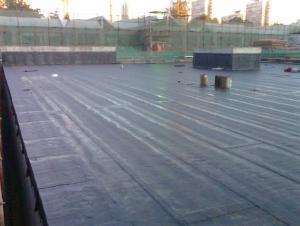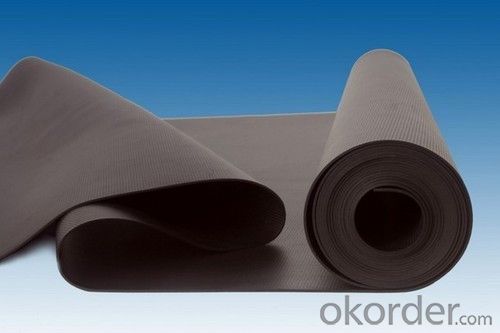EPDM Coiled Rubber Waterproof Membrane for Ponds
- Loading Port:
- Shanghai
- Payment Terms:
- TT or LC
- Min Order Qty:
- 10000 m²
- Supply Capability:
- 1200000 m²/month
OKorder Service Pledge
OKorder Financial Service
You Might Also Like
EPDM Coiled Rubber Waterproof Membrane for Ponds
Description Of EPDM Coiled Rubber Waterproof Membrane for Ponds:
1. EPDM waterproof membrane is made from ternary ethylene-propylene rubber, which is for waterproofing of exposed and non-exposed applications.
2. EPDM waterproof membrane production adopts the world-advanced equipment of cold feeding extrusion and continuous vulcanization technology.
3. EPDM waterproof membrane is of high elasticity among high polymer waterproof materials and becomes a world-popular waterproofing material.
Main Features of EPDM Coiled Rubber Waterproof Membrane for Ponds:
1. Excellent physical and mechanical performance
2. High tearing resistance
3. Good deformation adaptability
4. High puncture resistance
5. High aging resistance
6. UV resistance
Specifications of EPDM Coiled Rubber Waterproof Membrane for Ponds:
| Material | EPDM Rubber |
| Size | 1.2m (width)*20m (length) or customized, weldable type 2.05m or 4m width |
| Thick | 1.2mm, 1.5mm, 2.0mm |
| Type | Vulcanized & Weldable |
| Pattern | Non-reinforced (homogeneous) |
| Certificate | ISO9001/14001 |
Applications of EPDM Coiled Rubber Waterproof Membrane for Ponds:
1.Roofs, Basement, Toilets
2. Industrial and civil building waterproofing
3. Geosynthetic liner for swimming pool, channels, irrigation system
4. Especially suitable for projects with high requirements in durability, anti-corrosion and deformation.



IMages of EPDM Coiled Rubber Waterproof Membrane for Ponds:




FAQ of EPDM Coiled Rubber Waterproof Membrane for Ponds:
1. What are we supplying?
We are specialized in producing Colorful Asphalt Roof Shingle, SBS/APP modified bitumen waterproof membrane, Self adhesive bitumen waterproof membrane, PVC waterproofing membrane, EPDM rubber roofing membrane, Single Component Polyurethane Waterproof Coating, and Spray Polyurea Waterproof Coating
.
2. How Many years experience do we have?
We have been exported to more than 20 countries in the past 15 years.
3. How long do we usually reply your request?
We always reply our customer within 24 hours.
- Q: What are the requirements for the storage of waterproofing membranes?
- Waterproof membranes are generally flammable, so the storage area prohibits fireworks.
- Q: Can a waterproofing membrane be used on parking garages?
- Yes, a waterproofing membrane can be used on parking garages. Waterproofing membranes are commonly used in parking garages to prevent water penetration and protect the structure from moisture damage. They can be applied to the roof, walls, and floors of the garage to create a barrier against water intrusion, helping to extend the lifespan of the parking structure and prevent costly repairs.
- Q: Does a waterproofing membrane require a primer before application?
- In order to apply a waterproofing membrane, it is necessary to use a primer. The purpose of a primer is to improve the adhesion between the membrane and the substrate, guaranteeing a strong bond. Additionally, it acts as a sealant that protects the surface, preventing any moisture or impurities from affecting the efficiency of the waterproofing system. For a reliable and enduring waterproofing solution, it is crucial to apply a primer prior to the membrane.
- Q: Can a waterproofing membrane be used in cold climates?
- Yes, a waterproofing membrane can be used in cold climates. In fact, many waterproofing membranes are specifically designed to withstand extreme temperatures, including freezing conditions. These membranes are engineered to remain flexible and durable even in cold environments, ensuring effective protection against water infiltration and damage.
- Q: Can a waterproofing membrane be used on modified bitumen roofs?
- Yes, a waterproofing membrane can be used on modified bitumen roofs. In fact, it is a common practice to enhance the waterproofing capabilities of modified bitumen roofs by applying a separate waterproofing membrane on top. This additional layer provides an extra barrier against water infiltration and helps prolong the lifespan of the roof.
- Q: Can a waterproofing membrane be used on terraces or patios?
- Yes, a waterproofing membrane can be used on terraces or patios to prevent water penetration and protect the underlying structure from moisture damage.
- Q: Are waterproofing membranes suitable for residential applications?
- Yes, waterproofing membranes are suitable for residential applications. They can effectively prevent water intrusion and protect homes from moisture damage, making them an ideal solution for basements, foundations, roofs, and other areas prone to water leakage.
- Q: How is a waterproofing membrane installed?
- Installing a waterproofing membrane typically involves a step-by-step process to ensure proper installation and effective waterproofing. Here is a general overview of how a waterproofing membrane is installed: 1. Surface Preparation: The first step is to prepare the surface where the membrane will be installed. This involves cleaning the surface thoroughly and removing any dirt, debris, or loose materials. It is essential to create a clean and smooth surface for optimal adhesion of the membrane. 2. Priming: Next, a primer is applied to the surface. The primer helps improve adhesion between the membrane and the substrate. It also provides a uniform surface for the membrane to adhere to. 3. Membrane Application: The waterproofing membrane is then applied to the prepared surface. There are different types of membranes available, such as sheet membranes or liquid-applied membranes. Sheet membranes are typically rolled out onto the surface and adhered using a suitable adhesive or self-adhesive backing. Liquid-applied membranes are spread or sprayed onto the surface in multiple coats, allowing each coat to cure before applying the next one. 4. Seam and Joint Treatment: In areas where multiple sheets or sections of the membrane meet, seams and joints are treated to ensure a watertight seal. This may involve overlapping the sheets and applying a seam tape or using a liquid-applied sealant to fill any gaps or joints. 5. Protection and Drainage: Once the membrane is installed, it is essential to protect it from damage and provide proper drainage. This can be achieved by installing a protective layer, such as a geotextile fabric or a drainage board, over the membrane. These layers help prevent punctures or abrasions and allow any water that penetrates the surface to drain away effectively. 6. Quality Control: After the installation is complete, it is crucial to perform quality control checks to ensure the membrane has been installed correctly. This may involve visual inspections, conducting water tests, or using specialized equipment to test the integrity of the membrane. It is important to note that the specific installation process may vary depending on the type of waterproofing membrane used and the requirements of the project. It is recommended to follow the manufacturer's guidelines and consult with a professional waterproofing contractor for accurate installation instructions.
- Q: Does a waterproofing membrane require any maintenance?
- Yes, a waterproofing membrane typically requires some maintenance to ensure its effectiveness over time. Regular inspections, repairs, and cleaning are recommended to prevent any damage or deterioration.
- Q: Can a waterproofing membrane be used for historical buildings?
- Historical buildings can indeed benefit from the use of a waterproofing membrane. While it is vital to maintain the architectural integrity and historical significance of these structures, it is equally important to shield them from water damage. Waterproofing membranes offer an effective solution to prevent water infiltration, which can lead to decay or deterioration. These membranes can be applied to various surfaces, including roofs, walls, and foundations, without compromising the visual appeal of the historical building. It is essential to select a waterproofing membrane that is suitable for historical buildings, taking into account factors such as breathability, compatibility with existing materials, and adherence to preservation guidelines. By carefully choosing and correctly installing a waterproofing membrane, historical buildings can be safeguarded against moisture-related problems, ensuring their longevity and continued preservation.
Send your message to us
EPDM Coiled Rubber Waterproof Membrane for Ponds
- Loading Port:
- Shanghai
- Payment Terms:
- TT or LC
- Min Order Qty:
- 10000 m²
- Supply Capability:
- 1200000 m²/month
OKorder Service Pledge
OKorder Financial Service
Similar products
Hot products
Hot Searches
Related keywords

































